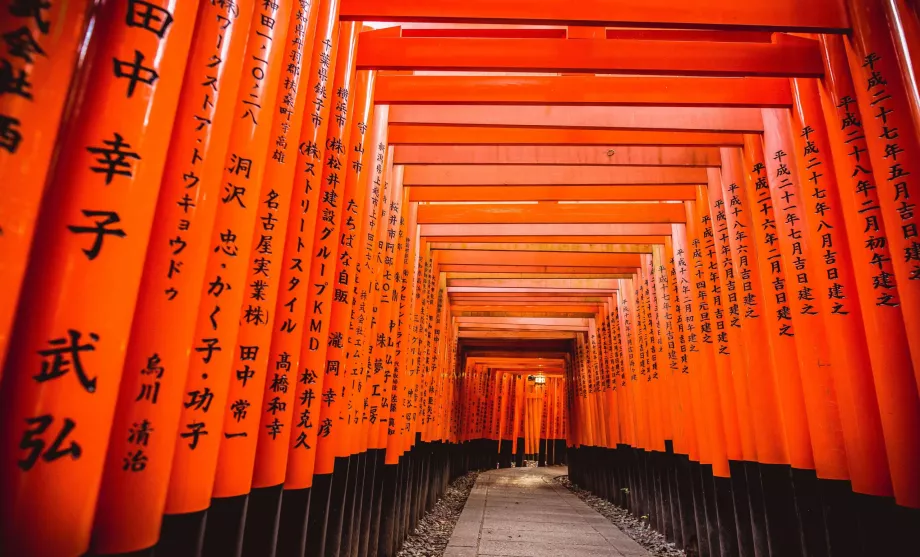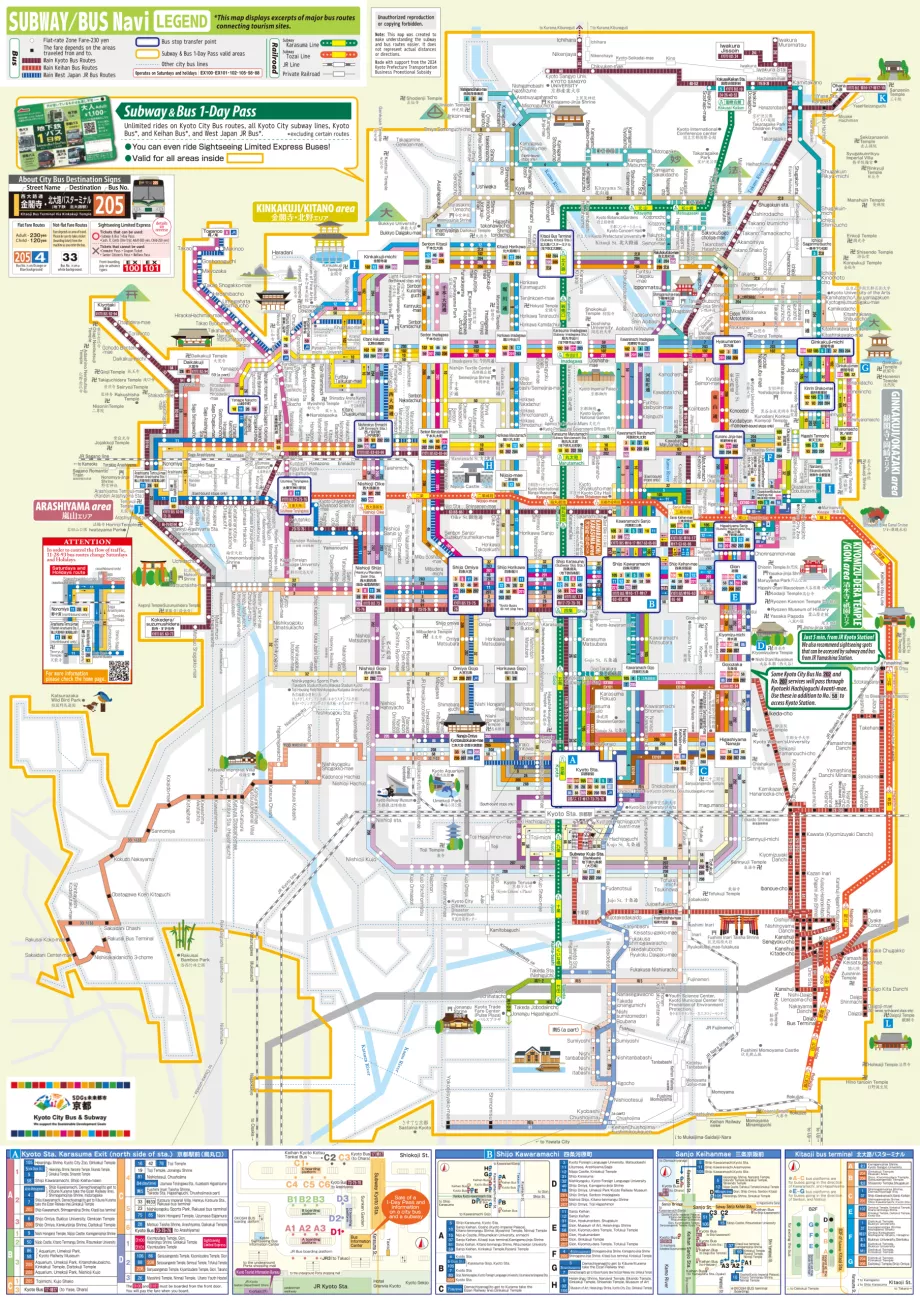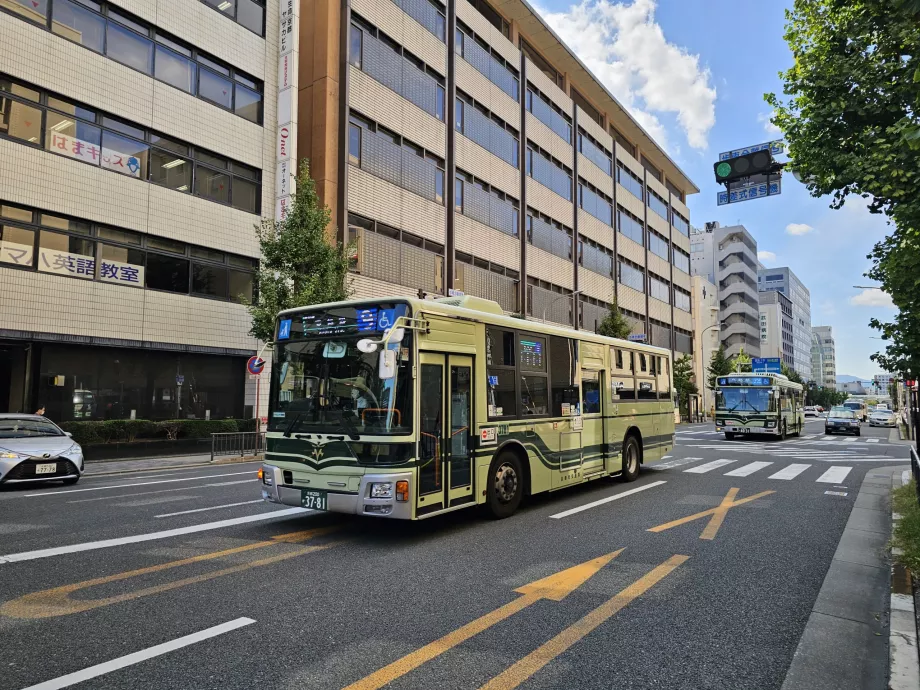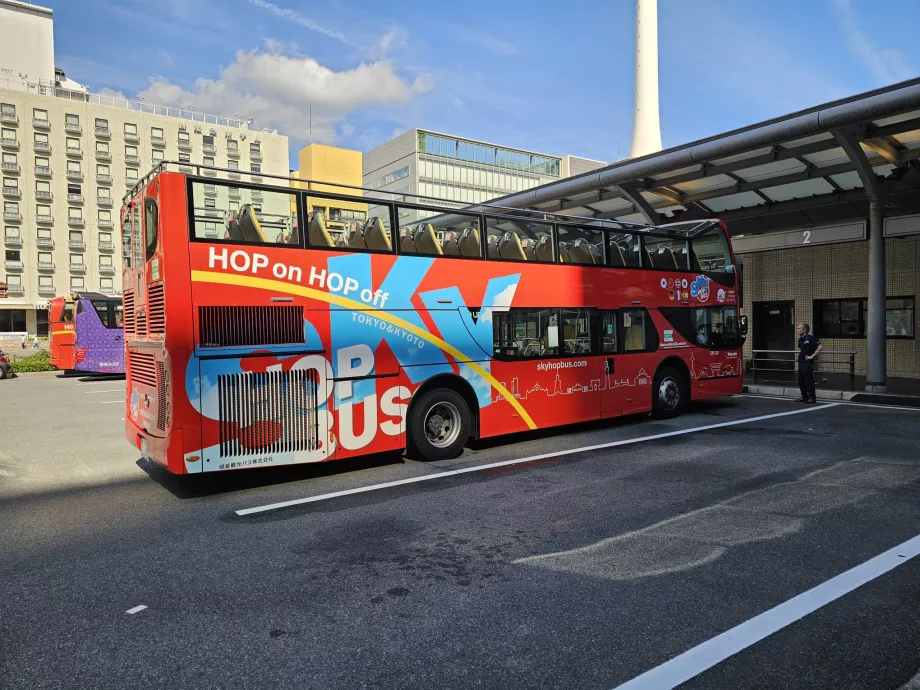Getting around Kyoto

Kyoto's public transport network is dense and includes a subway, several bus carriers, tourist buses and several rail carriers.
You will mostly use the buses to get to all the sights. However, expect long journey times and often very crowded cars.
The metro also provides fast connections, but unlike the buses, it serves more locals and doesn't go to many of the sights at all.
The fastest way to get to the Arashiyama area is by train.
Convenient day tickets
The fare system is different for different transport companies and, especially in the case of transfers or day tickets, it is quite difficult to know which lines a given ticket is valid for and which ones are not.
In Kyoto, there are two basic types of day pass + one popular pass for the entire Kansai area.
| Price | Validity | |
|---|---|---|
| Subway & Bus 1 Day | 1 100 jpy |
Kyoto Subway |
| Subway 1 Day | 800 jpy | Kyoto Subway |
| Kansai Railway Pass | 5 600 jpy - 2 days 7 000 jpy - 3 days |
Kyoto Subway Osaka Metro Private railways (Kansai region) ** Trams and some cable cars |
* For these carriers, the all-day ticket is only valid on some lines:
- Kyoto Bus - valid on all routes except routes 10, 18, 32, 34, 51, 54, 90, 95
- West JR Bus - valid only on Kyoto Station - Toganoo (Tako-Keihoku Line)
- Keihan Bus - valid only on lines 29, 29C, 84, 901
** Kansai Railway Pass within Kyoto is not valid on all rail carriers:
- JR trains - cannot be used
- Keihan Railway - can be used
- Eizan Railway - can be used except for boarding at Demachyianagi Station (so if you are transferring from Keihan Railway, you must pay for a ticket at the nearest station "Mototanaka" or walk about 1 km)
- Eizan cable cars - cannot be used
- Hankyu Railway - can be used
- Kintetsu Railway - can be used
- Randen Trams (Keifuku Railway) - cannot be used
Subway & Bus 1 Day
A full day ticket for both subway lines and all bus lines in Kyoto is the best value for getting around the city.
- 1 100 jpy
- Valid for 1 calendar day and not 24 hours
It is worthwhile if you take more than 4 subway or bus rides in 1 day, but you can easily manage this if you visit 2-3 sights that are further apart.
Additionally, individual fares are never transferable, so you pay a separate ticket for each bus ride.
For detailed information, visit the official website at city.kyoto.lg.jp.
Where to buy?
- Vending machines at each subway station (cash or Japanese transport cards only)
- Information centre at the bus station via Kyoto Station (see map)
- Daily 7:30am-7:30pm
- From the driver inside the bus when getting off
Subway 1 Day
A day pass for the subway only is not very convenient for tourists, as the subway only takes you to a limited number of sights.
- 800 jpy
- It is valid for 1 calendar day and not 24 hours
A regular single subway ticket costs around 260 jpy for a city trip, so a full day ticket is worth it for 3 or more subway rides and at most one bus ride (single day costs 230 jpy).
Check the official website city.kyoto.lg.jp for details.
Where to buy?
- Vending machines at each subway station (cash or Japanese transport cards only)
- Information centre at the bus station via Kyoto Station (see map)
- Daily 7:30am-7:30pm
Kansai Railway Pass
Valid for the whole of the wider Kansai area including Osaka, Kyoto, Nara or Kobe, the railway pass is more suitable for railway enthusiasts only.
To make it worthwhile, you would need to make 2 round trips each day on the long route (e.g. Osaka - Nara / Kobe / Kyoto) or 1 round trip on the long route and several shorter trips (at least 4-5).
| 5 600 jpy | 7 000 jpy |
|---|---|
| 2 days | 3 days |
The ticket is valid for the calendar days and not for 48 or 72 hours.
In addition to most private railways in Osaka, Kyoto, Kobe and Nara, the ticket is also valid on the Osaka and Kyoto subways. Conversely, the ticket is not valid on any JR trains (not even the JR Osaka Loop city line) and in Kyoto it is not valid on the Randen tram lines or Eizan cable cars.
The Kansai Railway Pass cannot be used on any bus lines either.
The subway pass also gives you discounts on admission to 30 selected attractions (usually around 10%), see list.
Where to buy?
- Online at Klook, kkday, waug, see information: surutto.com/kansai
- At two sales points in Kyoto, see list
When buying online, you must exchange the voucher for a physical card at any point of sale.
Transport Finder
There is no single search engine for all types of transport in Kyoto. You can either search on the websites of individual carriers, listed below, or via Google.com/maps.
Searching for public transport via Google works well, including displaying accurate prices.
However, Google Maps ignores the differences between the systems.
They will always find you the shortest possible route, but they don't take into account whether the routes are on the same fare. If not, you have to buy a new fare each time you change, making travel more expensive.
Frequent misunderstandings arise especially when using the Subway Bus 1-Day Pass, which is not valid on rail lines (such as JR or Randen when going to Arashiyama, Hankyu, or Keihan).
A useful leaflet with examples of the most common connections can be found on the subway and city bus websites: city.kyoto.lg.jp/pdf.
Metro and rail
Kyoto's basic transport network is 2 subway lines, supplemented by many private and state-run (JR) suburban railways.
These railways can often be used to get around the city, however single tickets and some day tickets are not compatible with each other.
See the Kyoto Metro chapter for details.
Buses
Buses are the main means of transport for tourists as they run to all the sights.
Travelling by bus is very convenient if you have paid for a day ticket for the subway + bus for 1,100 yen.
However, be aware that Kyoto is a big city with a lot of traffic lights and therefore the bus ride is often very long.
If you take a bus from the centre to the outskirts (for example, to the Arashiyama area or Kinkakuji Temple), the journey will take about 45 minutes.
On routes to tourist attractions (especially from/to the Gion and Higashiyama districts), there are often long lines at bus stops for 40-60 minutes.
Single fare
Throughout Kyoto, a flat fare applies for all bus operators 230 jpy.
On the outlying parts of lines 16, 17, 18, 19, 32, 34, 52, 54, 90, 95 (Kyoto Bus), 33 (Kyoto City Bus) and all Keihan Bus lines, fares are based on distance travelled.
- Boarding is always via the rear door
- If you are travelling on a route with a flat fare of 230 yen (the vast majority of routes), you do not need a ticket when boarding
- If you are on a line with a section fare, take a ticket at the door and then pay the appropriate amount at the driver according to the ticket, or attach a transport card (Icoca, Suica, etc.) to the reader when boarding and alighting
- Flat fare 230 jpy is paid only when you get off at the driver in exact cash or with one of 10 Japanese transport cards (Icoca, Suica and others)
- If you don't have the exact amount, there is a cash changer at the driver's counter where you can change a 1,000 yen note into small change
- Always get off at the front door to pay the fare
- There is no discounted transfer fare. You always pay 230 jpy per ride.
On the Kyoto bus route map, you'll notice stops included in the flat fare are marked with a white circle and stops included in the section fare are marked with a black square.
Kyoto City Bus
Kyoto's largest carrier operates green buses on many routes throughout the city.
All of this carrier's routes operate only within the flat fare zone for 230 jpy except for route 33 in the direction of Katsura Station.
- The all-day bus + metro ticket is valid on all routes including the EX100 and EX200 tourist routes.
Official website: city.kyoto.lg.jp
Kyoto Bus
Cream buses with a red stripe run from Kyoto Station to areas such as Arashiyama or vice versa to the northeast towards Iwakura and Ohara.
Most routes heading to tourist areas are included in the 230 yen flat fare zone.
- All-day bus + subway tickets are valid only on lines 16, 17, 24, 26, 40, 52, 63, 65, 66, 73, 75, 76, 92, 94
Official website: kyotobus.jp
Keihan Bus
Red and white buses operate in the area on the southwestern edge of the city.
Fares on all routes are based on the number of stops travelled and range from 230 jpy to 390 jpy.
- The bus + metro day pass is only valid on lines 29, 29C, 84, 301
Official website: keihan.co.jp/buses
West JR Bus
The bus arm of the railway company JR-WEST operates two lines in Kyoto. Both have flat fares 230 jpy.
On both lines you can use the JR Pass or the regional variant of the JR-WEST Pass.
- Line 205 - runs from Kyoto Station to Ritsumeikan University and does not pass major tourist sites
- No bus + subway day pass applies
- Takao-keihoku Line - runs from Kyoto Station to the Toganoo tourist area in the northwest.
- All-day bus + subway ticket applies
Official website: nishinihonjrbus.j-server.com.
Tourist sightseeing buses
There are two companies operating tourist sightseeing buses in Kyoto on which none of the above tickets apply.
These buses are expensive, but they don't have the queues that form for regular buses.
K'Loop
K'Loop operates on three different routes. However, the frequency is 80 minutes, so a bit of time planning is required to use these buses.
Buses run to the following sights, for example: Fushimi Inari-Taisha, Nijo Castle, Kinkakuji, Toji Temple, Ginkakuji, Gion.
Tickets are sold in the following variations:
- 1-day ticket - 1 500 jpy
- 1 ride - 500 jpy
For details, visit kloop.jp.
Sky Hop Bus
Although the company formally operates 3 routes, in reality they all run on one route. The only difference is the number of stops.
All routes always depart from Kyoto Station.
For example, buses run to the following sights: Nijo Castle, Kinkakuji, Kyoto Imperial Palace, Ginkakuji, Gion.
Due to the high prices and the limited number of attractions that the buses go to, we do not recommend this mode of transportation.
Tickets are only sold in full-day or 2-day options and you cannot buy a single ticket for just 1 ride.
- 1-day ticket - 4 000 jpy
- 2-day ticket - 6 000 jpy
Tickets can be purchased on the bus (cash and credit card payments are accepted) or online at skyhopbus.com/kyoto.
Taxi, Uber
Typical black cabs are an extremely popular mode of transport for locals and tourists alike and are literally ubiquitous.
You can flag down a taxi by waving anywhere on the street and official taxi stands are very common, where many taxis are always waiting, often at shopping malls, monuments or metro stations.
Taxi travel in Kyoto is very safe and overpriced fare scams do not happen here.
Taxis can usually be paid for in cash and many taxis also accept regular Visa, Mastercad or American Express cards or Japanese transport cards (Icoca, Suica and others).
Driving is always by meter. Common fares are as follows:
- 660 jpy - first 2 km
- 80 jpy - every additional 296 metres or 1 minute wait (larger taxis have a slightly higher fare)
Usually, you will pay around the same price for a trip across the centre. 2 000 jpy.
Tip
Tipping is not common in Kyoto when taking a taxi.
However, you can round the amount up to the nearest ten. If you have to pay 1,900 yen, it's okay to leave the taxi driver 2,000 yen.
Mobile apps
While there are mobile apps like Uber and DiDi in Kyoto, the prices are always the same as regular taxis and are only calculated based on the actual ride (according to the taximeter).
The advantage, however, is that you can always pay by card when using the apps.
Any questions left?
If you have any questions or comments about the article...






